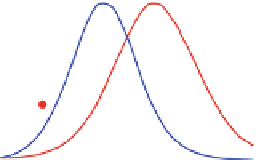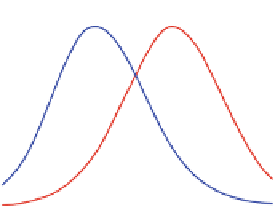Biomedical Engineering Reference
In-Depth Information
a
b
19
534 nm
555 nm
1,0
554 nm
13
538 nm
1,0
18
1
12
0,8
0,8
11
17
77 K
293 K
77 K
2
293 K
0,6
10
0,6
16
9
2
0,4
15
0,4
8
1
0,2
14
7
0,2
6
0,0
13
0,0
5
520
540
560
580
520
540
560
580
, nm
λ
, nm
λ
Fig. 4.34
Dependence of the photoluminescence mean decay
τ
on registration wavelength
(
λ
reg
) for TOPO-capped CdSe/ZnS QD (
d
CdSe
=
3.0 nm,
n
ZnS
=
2) at 293 K (
1
) and 77 K (
2
)
for QDs (
a
)and“QD
+
(m-Pyr)
4
-CuP” nanoassemblies (at molar ratio
x
=
1) (
b
) in methylcy-
clohexane/toluene (6:1) mixture. QD PL non-exponential decays
τ
have been fitted by
I
(
t
)=
A
i
×
exp
(
−
t
/
τ
)
upon excitation at
λ
=
410 nm, and the mean lifetime values have been
∑
i
exc
i
2
calculated as
τ
=
∑
(
A
i
×
τ
)
/
∑
(
A
i
×
τ
)
i
77 K are noticeably longer relative to those measured at 293 K. In addition, at 295 K
QD instantaneous spectra are the same practically at various delay times, while at
77 K the red shift of these spectra is observed upon increase of a registration delay
time. Taken together, all these PL decay findings for alone QDs in a temperature
range of 300-77 K cannot be described by a thermal equilibrium between dark and
bright excitonic states as far as such effects manifest themselves at
T
50 K [
80
,
176
]. The realistic mechanisms of exciton relaxation in this case may be dominated
by trapping dynamics, since the trap depths vary across the QD ensemble and also
fluctuate in time for individual QDs [
132
].
In the case of “QD
< ∼
(m-Pyr)
4
-CuP” nanoassemblies, QD PL decays are multi-
exponential throughout the total PL band both at room and low temperature
(Fig.
4.34
b).
+
values change only slightly upon variation of the detection
wavelength. At 293 K, the shortening from
τ
τ
≈
14
.
5 ns for alone QDs down
to
9 ns for nanoassemblies is a direct evidence of QD PL quenching in
nanoassemblies due to both non-FRET and FRET processes. At 77 K, PL spectra
of QDs in nanoassemblies are blue shifted with respect to those for individual QD.
This may be considered as an additional support of the influence of attached CuP
on the QD ligand-induced phase transition. Data presented in Fig.
4.34
show also
that in contrast to alone QDs, the temperature lowering down to 77 K leads to a
strong shortening of mean
τ
≈
11
.
τ
values even for the PL long wavelength region (from
∼
8 ns). The interpretation of these results is also connected with the
TOPO capping layer phase transition perturbed by attached porphyrin molecules.
The existence of an additional PL quencher (on average one attached CuP molecule)
may influence indirectly the relative position of excitonic and trap states of the
QD itself upon temperature lowering as well as from the competitive non-radiative
channels connected with (m-Pyr)
4
-CuP molecules.
18 ns down to
∼



















































































































